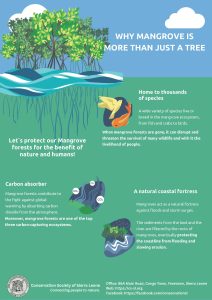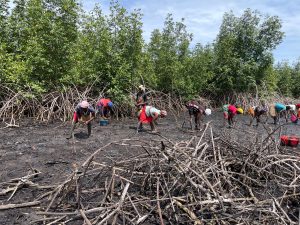The International Day of Mangrove Ecosystems is observed annually on July 26th. This day was designated by UNESCO to raise awareness about the vital role mangroves play in maintaining healthy coastal ecosystems and to promote their conservation and sustainable management. Mangroves, unique coastal forests found in tropical and subtropical regions, are among the most productive and ecologically significant ecosystems on Earth.
Importance of Mangroves
Breeding Area for Fishes
Mangroves serve as crucial breeding and nursery grounds for a wide variety of marine life, including many fish species. The intricate root systems of mangrove trees provide shelter and protection for juvenile fish, crustaceans, and mollusks from predators. This makes mangroves essential for the replenishment and sustainability of fish populations, which are critical for both commercial and subsistence fishing communities.
Livelihood for People
Mangroves are a source of livelihood for millions of people worldwide. They support fisheries, which provide food and income for coastal communities. In addition, mangroves are harvested for timber and non-timber products such as honey, tannins, and traditional medicines. Ecotourism centered around mangrove forests also offers economic opportunities, promoting conservation while providing financial benefits to local populations.

Prevent Erosion
The dense root networks of mangrove trees stabilize coastal sediments, reducing erosion caused by wave action, currents, and storms. By holding the soil together, mangroves protect shorelines from being washed away, which is particularly important for low-lying island nations and coastal areas that are vulnerable to the impacts of climate change.
Prevent Flooding
Mangroves act as natural buffers against storm surges and tsunamis. Their roots dissipate wave energy, reducing the height and impact of waves that reach the shore. This protective function helps to minimize the damage caused by extreme weather events, safeguarding human lives, infrastructure, and coastal habitats.
Biodiversity Hotspot
Mangrove ecosystems are incredibly biodiverse, hosting a wide range of species, including various plants, birds, mammals, and marine organisms. They provide habitat for endangered species and serve as critical stopover points for migratory birds. The unique environment created by mangroves supports species that are specially adapted to the brackish water and fluctuating conditions of coastal areas.


Carbon Sink
Mangroves are powerful carbon sinks, sequestering significant amounts of carbon dioxide from the atmosphere and storing it in their biomass and sediments. This carbon storage capability helps to mitigate climate change by reducing the concentration of greenhouse gases in the atmosphere. Mangroves can sequester up to four times more carbon than tropical rainforests, making them a vital component in global efforts to combat climate change.
Conclusion
The International Day of Mangrove Ecosystems serves as a reminder of the indispensable roles that mangroves play in environmental health and human well-being. Protecting and restoring these vital ecosystems is crucial for sustaining biodiversity, supporting coastal communities, and combating climate change. By raising awareness and promoting action, we can ensure that mangrove forests continue to thrive for future generations.




